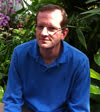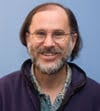About This Webinar
Update: Additional Questions from the Webinar Answered below.
Enabling Structured Illumination Microscopy in Thick Tissue with Adaptive Optics

Peter Kner
University of Georgia
[email protected]
Superresolution Microscopy allows imaging of biological samples with resolutions of 120 nm to 20 nm. Significantly better than the 250 nm resolution achievable with diffraction limited imaging. But superresolution techniques have so far been limited to thin biological samples. Dr. Kner will discuss the lab’s efforts to apply adaptive optics to microscopy and to extend superresolution microscopy to thick tissue using adaptive optics. They have demonstrated imaging with 120 nm resolution through C. elegans roundworms using structured illumination microscopy, which provides a two-fold increase over the diffraction limited resolution, in combination with adaptive optics. Adaptive Optics increases the imaging fidelity and increases the Signal to Noise Ratio by 50%. The aberrations can be corrected over a 35µm × 35µm field of view with one wavefront correction setting, demonstrating that AO can be used effectively with widefield superresolution techniques.
 Adaptive Optical Microscopy using Direct Wavefront Sensing
Adaptive Optical Microscopy using Direct Wavefront Sensing
Joel Kubby
Professor & Chair, Electrical Engineering Department, Baskin School of Engineering, University of California Santa Cruz
[email protected]
This talk will review the development of wide-field and confocal microscopes with direct wavefront sensing and adaptive optics for correcting aberrations when imaging through thick tissues (Drosophila embryos and mouse brain tissue). In order to make direct wavefront measurements in biological specimens, they have modified the laser guide-star techniques used in astronomy for measuring wavefront aberrations that occur as star light passes through Earth’s turbulent atmosphere. Sodium atoms in Earth’s mesosphere, at an altitude of 95 km, are excited to fluoresce at resonance by a high-power sodium laser. The fluorescent light creates a guide-star reference beacon at the top of the atmosphere that can be used for measuring wavefront aberrations that occur as star light passes through the atmosphere. They have developed a related approach for making wavefront measurements in biological specimens using cellular structures labeled with fluorescent proteins for use as laser guide-stars. Using adaptive optical microscopy they show that the Strehl ratio, the ratio of the peak intensity of an aberrated point source relative to the diffraction limited image, can be improved by an order of magnitude when imaging through thick tissue samples, enabling near diffraction limited deep tissue imaging.
Additional Questions & Answers from the Webinar
Q: Are the strehl ratios different for the same sample using 2p or 1p confocal?
A: We haven't measured the Strehl ratio for the 2-p yet. We are just getting started with that. We are going deeper with the 2-p, so scattering will become important.
Q: Can AO be achieved by using purely numerical compensation?
A: There are computational approaches for compensation. These are usually too slow for live imaging on dynamically changing samples.
Q: Do you see the ability to retrofit AO to existing confocal scopes?
A: We have retro-fit commercial microscopes with AO. We typically re-use the microscope frame and tube lens. We access the light path through one of the imaging ports. We built our own confocal scan optics, so we haven't tried to retrofit into commerical scan optics. There is also an AO add-on available from Imagine Optics, although I have not used that. One challenge will be making modifications to the commercial software that comes with the microscope. Some microscope vendors are not willing to provide their source code. Nonetheless, some researchers have published their source code on-line that may be helpful.
Q: Does the actual number or density of fluorescent guide stars matter in AO correction?
A: The number and density of guide-stars does matter. As I mentioned during my talk, the AO correction only extends a finite distance away from the guide-star, so for a wide correction field, you may need to stitch together individual correction patches. We call those "isoplanatic patches". We discuss the size of those patches in some of our publications. They are posted on-line at:
http://cfaom.soe.ucsc.edu/
Q: I would like to ask regarding temporal resolution.
A: The temporal resolution is currently limited by the amount of time it takes to make a wavefront measurement, which in turn depends on the brightness of the guide-star. For the samples we have worked with so far, this takes 30-50 ms, but we are working on approaches to shorten this time. When we do fast imaging, we use a calibrated mirror and directly place the correction from the wavefront sensor on the mirror rather than using closed loop control. This approach is described in our paper on live imaging that is posted on the website listed above.
About Our Speakers:
Peter Kner received his PhD in physics from the University of California Berkeley in 1998 in the field of ultrafast spectroscopy. After graduating, he joined a Silicon Valley startup developing semiconductor lasers. In 2004, he started working in the field of microscopy, working with John Sedat and Mats Gustafsson at UCSF, where he built the first microscope capable of live structured illumination microscopy. He joined the engineering faculty at the University of Georgia in January, 2009.
Joel Kubby is the Department Chair of Electrical Engineering in the Baskin School of Engineering at the University of California at Santa Cruz. His research is in the area of Micro-Electro-Mechanical Systems (MEMS) with applications in Optics, Fluidics and Bio-MEMS. Prior to joining the University of California at Santa Cruz in 2005, he was an Area Manager with the Wilson Center for Research and Technology and a Member of Technical Staff in the Webster Research Center in Rochester New York (1987-2005). Prior to Xerox he was at the Bell Telephone Laboratories in Murray Hill New Jersey working in the area of Scanning Tunneling Microscopy (STM).